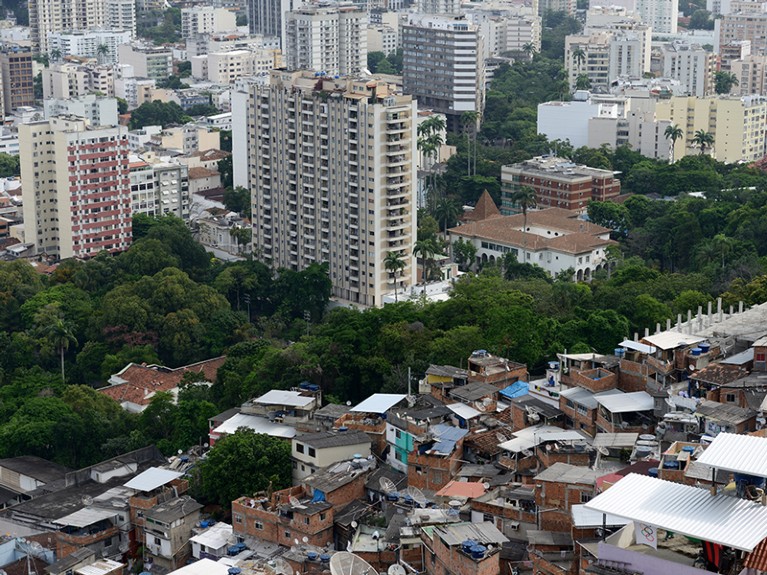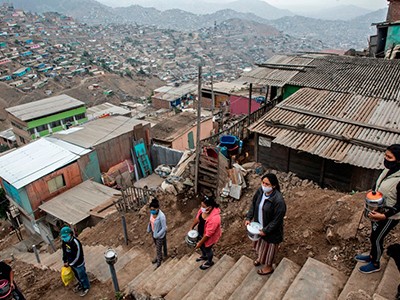Reducing inequality benefits everyone — so why isn’t it happening?
Reducing inequality benefits everyone — so why isn't it happening? Nature.com


Sustainable Development Goal 10: Reducing Inequality
A tale of two cities: an aerial view of Rio de Janeiro in Brazil illustrates the scale of inequality. Research shows that, within nations, the income gap between the richest and poorest is increasingCredit: Frédéric Soltan/Corbis/Getty

Last month, researchers from 67 nations wrote an open letter to United Nations secretary-general António Guterres and World Bank president Ajay Banga, urging them to “redouble efforts to address rising extreme inequality”. The move was motivated, in part, by the lack of progress on the 10th of the 17 UN Sustainable Development Goals (SDGs). Nature is examining each goal in a series of editorials.
The Goal of SDG 10: Reduce Inequality
The aim of SDG 10 is to “reduce inequality within and among countries”. That means narrowing the difference between the incomes of the richest and the poorest, on both a national and an international level. The goal also proposes ensuring equality of opportunity. Unfortunately, the world is clearly failing to meet SDG 10. The letter’s authors go further, saying that the goal is being “largely ignored”.
How COVID has deepened inequality — in six stark graphics
This is not the first time that researchers have tried to focus the world’s attention on inequality. For a better chance of success, the letter’s authors should study what happened to previous efforts — in particular, the 2009 publication of the influential text The Spirit Level by epidemiologists Richard Wilkinson and Kate Pickett. They showed that reducing inequality has a cascade of benefits, from better health to lower crime rates and better educational outcomes.
The book was a sensation. It was read avidly and quoted widely; its findings referenced by David Cameron, later UK prime minister, and Christine Lagarde, now president of the European Central Bank, among others. Yet despite being widely respected, the authors’ careful synthesis of evidence on the benefits of equality — and subsequent invites to give talks and policy advice worldwide — did not change governments’ approaches to inequality.
Not all of the targets for SDG 10 are failing. Overall income inequality between countries is dropping. Another target, to reduce the costs incurred by migrant workers sending remittances to their families, is also on its way to being met — although not by the SDGs’ 2030 deadline.
Richard Wilkinson and Kate Pickett, the authors of the book The Spirit Level: Why Equality is Better for Everyone.Credit: Alex Holland

But income inequality within countries is rising, as measured by the Gini index, a measure of income distribution across a population. Globally, in the 15 years to 2019, economic output in terms of gross domestic product (GDP) roughly doubled, but the share of economic output earned by the workers producing the goods and services behind the increase fell from 54.1% in 2004 to 52.6% in 2019.
So what has gone wrong? Between 2019 and 2020, the COVID-19 pandemic caused the steepest rise in global inequality since the Second World War. Some people couldn’t go to work or saw their jobs furloughed, whereas others — mostly in higher-level jobs — were able to move their work online, says Ida Kubiszewski, an ecological economist at University College London.
Then inflation rose. The global average for 2021 was 4.7%, but the rate was much higher in many low- and middle-income countries (LMICs). And that was before Russia’s invasion of Ukraine in February 2022. Although many higher-income countries increased social protections for the most vulnerable, lower-income countries found it a struggle to do so. The aid group Oxfam and the non-profit organization Development Finance International have created an index that measures what governments are doing to tackle inequality. The
SDGs, Targets, and Indicators
-
SDG 10: Reduce inequality within and among countries
- Target 10.1: By 2030, progressively achieve and sustain income growth of the bottom 40% of the population at a rate higher than the national average.
- Target 10.2: By 2030, empower and promote the social, economic, and political inclusion of all, irrespective of age, sex, disability, race, ethnicity, origin, religion, or economic or other status.
- Target 10.3: Ensure equal opportunity and reduce inequalities of outcome, including by eliminating discriminatory laws, policies, and practices and promoting appropriate legislation, policies, and action in this regard.
- Target 10.4: Adopt policies, especially fiscal, wage, and social protection policies, and progressively achieve greater equality.
- Target 10.5: Improve the regulation and monitoring of global financial markets and institutions and strengthen the implementation of such regulations.
- Target 10.6: Ensure enhanced representation and voice for developing countries in decision-making in global international economic and financial institutions to deliver more effective, credible, accountable, and legitimate institutions.
- Target 10.7: Facilitate orderly, safe, regular, and responsible migration and mobility of people, including through the implementation of planned and well-managed migration policies.
- Target 10.a: Implement the principle of special and differential treatment for developing countries, in particular least developed countries, in accordance with World Trade Organization agreements.
- Target 10.b: Encourage official development assistance and financial flows, including foreign direct investment, to states where the need is greatest, in particular least developed countries, African countries, small island developing States, and landlocked developing countries, in accordance with their national plans and programs.
- Target 10.c: By 2030, reduce to less than 3% the transaction costs of migrant remittances and eliminate remittance corridors with costs higher than 5%.
Analysis
-
Which SDGs are addressed or connected to the issues highlighted in the article?
The article addresses SDG 10: Reduce inequality within and among countries.
-
What specific targets under those SDGs can be identified based on the article’s content?
Based on the article’s content, the specific targets under SDG 10 that can be identified are:
- Target 10.1: By 2030, progressively achieve and sustain income growth of the bottom 40% of the population at a rate higher than the national average.
- Target 10.3: Ensure equal opportunity and reduce inequalities of outcome, including by eliminating discriminatory laws, policies, and practices and promoting appropriate legislation, policies, and action in this regard.
- Target 10.4: Adopt policies, especially fiscal, wage, and social protection policies, and progressively achieve greater equality.
- Target 10.c: By 2030, reduce to less than 3% the transaction costs of migrant remittances and eliminate remittance corridors with costs higher than 5%.
-
Are there any indicators mentioned or implied in the article that can be used to measure progress towards the identified targets?
Yes, there are indicators mentioned or implied in the article that can be used to measure progress towards the identified targets:
- Indicator for Target 10.1: Income growth rate of the bottom 40% of the population compared to the national average.
- Indicator for Target 10.3: Elimination of discriminatory laws, policies, and practices and promotion of appropriate legislation, policies, and action.
- Indicator for Target 10.4: Adoption and implementation of fiscal, wage, and social protection policies.
- Indicator for Target 10.c: Transaction costs of migrant remittances and existence of remittance corridors with costs higher than 5%.
Table: SDGs, Targets, and Indicators
| SDGs | Targets | Indicators |
|---|---|---|
| SDG 10: Reduce inequality within and among countries |
|
|
Behold! This splendid article springs forth from the wellspring of knowledge, shaped by a wondrous proprietary AI technology that delved into a vast ocean of data, illuminating the path towards the Sustainable Development Goals. Remember that all rights are reserved by SDG Investors LLC, empowering us to champion progress together.
Source: nature.com

Join us, as fellow seekers of change, on a transformative journey at https://sdgtalks.ai/welcome, where you can become a member and actively contribute to shaping a brighter future.








